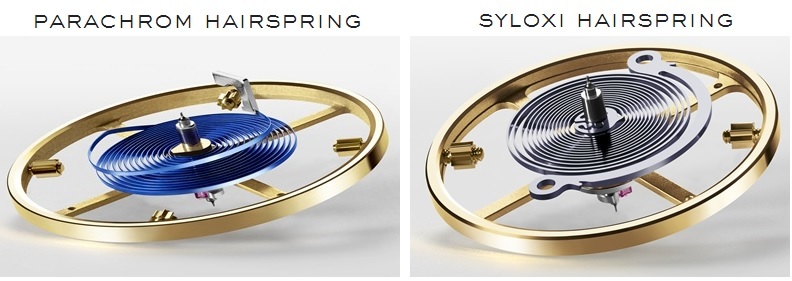The Silicon Revolution: Silicon balance spring and beyond in watchmaking
Why are watchmakers switching to a silicon balance spring?
Let's examine silicon and how the world's best watchmakers use it in their most innovative movements.
It's no secret that with all the electronic equipment that surrounds us each day, between cellphones, tablets, monitors, TVs, airport security scans, and more, we are exposed to higher levels of EMFs or electromagnetic frequencies. This is probably the worst thing that ever happened to mechanical watches as we know it since the Quartz crisis. Luckily, luxury watchmakers are using a space-age material to combat these forces.
Why are watchmakers switching to a silicon balance spring?
Let's examine silicon and how the world's best watchmakers use it in their most innovative movements.
It's no secret that with all the electronic equipment that surrounds us each day, between cellphones, tablets, monitors, TVs, airport security scans, and more, we are exposed to higher levels of EMFs or electromagnetic frequencies. This is probably the worst thing that ever happened to mechanical watches as we know it since the Quartz crisis. Luckily, luxury watchmakers are using a space-age material to combat these forces.
Introduction
A Revolutionary New Material
Silicon (also known as silicium) found a new place in watchmaking and has gained momentum in the last decade or so. This material has incredible resilience when it comes to shock and is impervious to magnetic interference. Watchmakers are seeing the value in adopting this versatile material that is lighter yet harder than steel into their engineering. It improves stability, performance, accuracy, and resistance to magnetic interferences and thermal fluctuations. It also can keep its shape forever and never requires any lubrication.
The most common use of silicon in a watch movement is the balance spring or hairspring. The combination of these two parts together is called the oscillator. The hairspring is one of the smallest components in a watch but also is one of the most critical in keeping the watch precise.
The oscillations in the movement depend on the balance spring to stay accurate. The less affected the hairspring is to external influences such as shock and electromagnetic interference, the more precise the movement will be.
Omega Si14 Balance Spring
Balance springs are traditionally comprised of several materials and now, with the advent of the computer and advanced industrial technology, silicon balance springs can be computer generated to perfection as is with Omega's Si14 balance springs which are three times finer than a human hair. Click on the video to get a glimpse at Omega's Si14 balance springs.
Rolex Syloxi & Parachrom
Is Rolex Switching from Blue Parachrom to Syloxi Silicon-Based Hairsprings?
Rolex was late in the game when it came to the use of silicon in their movements but has made some cautious moves with its uses of the material with their new Syloxi balance springs. Blue Parachrom, on the other hand, or Parachrom Bleu as they call it is their patented paramagnetic and shock-resistant balance spring using niobium-zirconium, and oxygen alloys.

The key difference is not just in the material used to create the two different springs, but the way that Syloxi balance springs are attached to the balance staff and the balance bridge. Aside from having improved geometry of the spring itself, the new silicon-based Syloxi balance spring has a more pliable central area that doesn't require the use of glue to be attached to the balance staff. It holds itself flush against the balance bridge, lying perfectly flat which improves its alignment with the balance bridge. The less sway there is in the hairspring during movement, the more energy can be kept within the oscillator.
The silicon Syloxi hairspring is a more recent and discreet innovation than Rolex and is made entirely in-house. It has so far only been introduced to a line of ladies' watches. This seemed like a safe bet for a brand like Rolex to test out the new technology in a way that won't require that they update all their calibers and watches. It is indicative that they are possibly split testing the two different types of balance springs to see which will be the way of the future for Rolex.
Patek Philippe Oscillomax
Patek Philippe Silinvar
The inventor of the wristwatch introduced the use of silicium in their balance wheel and their hairsprings in 2006. They collaborated with Rolex and the Swatch Group (Omega, Breguet) to develop their silicon springs. The results are Silinvar® and oxidized Silinvar® which gave birth to the silicon-based components like the Pulsomax escapement, the GyromaxSi balance, and the Spiromax hairspring. Aside from a few high-complication watches, Patek Philippe is going to be replacing all their balance springs with the new silicon Silinvar® hairsprings. The trifecta has been branded the Oscillomax. Any time you see this on a Patek Philippe watch you will know you are fully loaded with the latest and greatest in silicon components. For the time being, their advanced research department is looking into more and more ways to exploit the advantages of silicon. Click on the video to view Patek Philippe's Oscillomax at work.
Ulysse Nardin Silicon Flying Silicon Anchor Escapement
Ulysse Nardin Flying Silicon Anchor Escapement
Ulysse Nardin was the first watchmaker to ever use silicon hairspring in their watches. Their 2001 Edition of the iconic watch, the Ulysse Nardin Freak was the first to ever use the new revolutionary material in their escapement wheel. Click on the video to have a look at how Ulysse Nardin uses silicon.
Girard-Perregaux Constant Escapement
Girard-Perregaux Constant Escapement